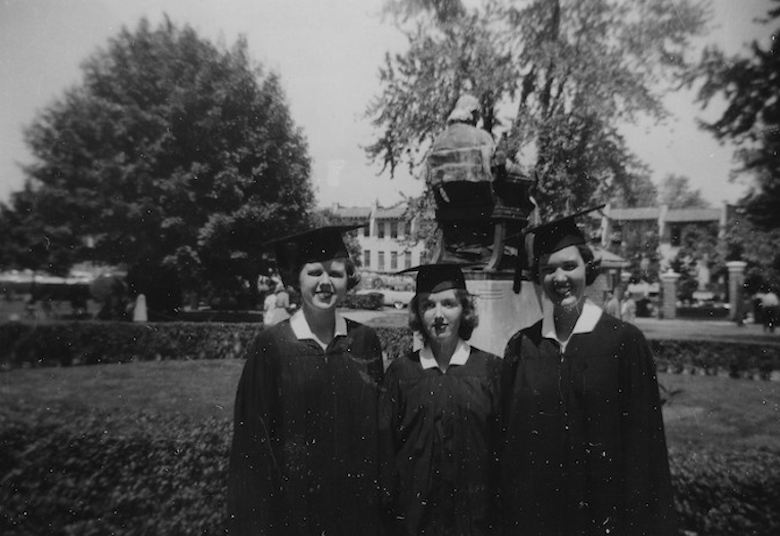Alumna Was Third Sister in Family to Attend Georgetown’s School of Nursing
March 4, 2021 – When Nancy Geatz Quinn enrolled at Georgetown, she became the third sister in her family to study nursing on the Hilltop.
Her oldest sister Jeanne had graduated with the diploma in nursing in 1945, and her sister Patricia was the only student to receive the BSN in 1951.
“I had three sisters who were nurses,” said Quinn, who herself graduated with the BSN in 1955. “I wanted to be a nurse, and two of them had gone to Georgetown, and so I went to Georgetown, too. Georgetown was the only place to which I’d applied. I really don’t think I knew what it meant to be getting a degree in nursing. I was just going to be a nurse.”
Seventy years later, she recalled watching her sister Patricia, who had transferred to Georgetown’s nursing program after two years of study at Notre Dame in Maryland, graduate in 1951.
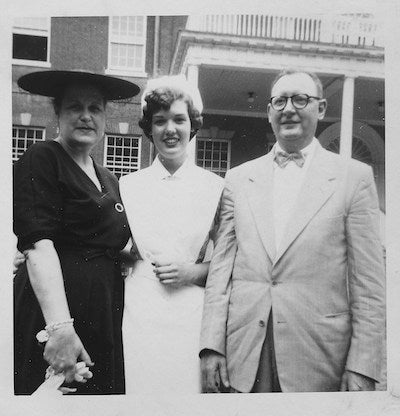
“She graduated as the only student receiving a bachelor of science in nursing,” Quinn said. “So, she was the only one that stood up when her degree was conferred. And I and my parents . . . we were very proud of her.”
‘Operated as a Unit’
Quinn, who grew up in a small town in Maryland, had attended an all-girls school with 25 other students. When she arrived at Georgetown, the nursing students formed a tight-knit group.
“When we got there, we had a scheduled week,” she said. “We kind of operated as a unit. We all had the same classes at the same time, at least in the first two years, I would say. They were just nursing students for the most part.”
She specifically noted Dr. William Taylor and Dr. Richard Weber, both of whom were science professors.
“They lectured at lightning speed,” Quinn said. “So, it was difficult, if not impossible to take notes. So, you bought notes from someone else. They were certainly the teachers, the instructors that stand out because everybody was terrified of them.”
In her recollection, most classes were with nursing students only, and the class or two in which a couple of pre-med male students joined them “caused a bit of a flutter,” but were an “aberration.”
Classes and Clinicals
During the first two years of study of the four-year BSN Program, Quinn said nursing students mostly took their College coursework.
“By junior year, we were spending a lot of time in the hospital,” she said. “And so, your classes were sometimes in the hospital in a classroom, associated with whatever service you were working on. If you were on the surgical unit, your classes would be affiliated with that, and so forth.”
“We had a class ‘nursing arts,’” she mentioned during the interview, “and this is where you learned to make a bed, to bathe the patient, to take blood pressures, do injections, all those kinds of things.” A clinical instructor, who “wasn’t at [the students’] elbow every minute,” was around to answer questions and ensure proper care was being given by the student nurses.
The Sisters of Charity of Nazareth ran the floors of Georgetown Hospital. Additionally, Quinn remembered having her pediatric rotation at DC General and her psychiatric rotation at the Seton Institute, as well as caring for people in the community through the visiting nurses.
“We went to school in the summertime,” Quinn added. “I think this is how they managed to get all the class time in. I think between our freshman and sophomore years, we had several weeks [of] vacation that summer.”
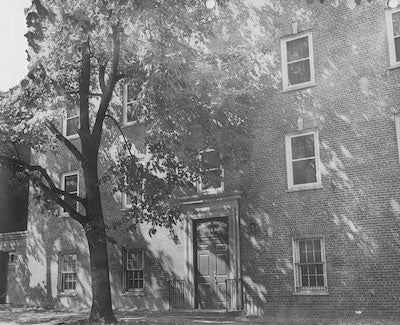
Dorm Living
Quinn said that in their first year, the nursing students lived in the original St. Mary’s Hall (which was on Prospect Street), but then moved into the old hospital that is along 35th Street. That building featured a switchboard in the lobby and a phone on each hallway.
“We had a smoker,” she said with respect to St. Mary’s Hall. “So that’s where all the social activity took place. So, it was just one of the dorm rooms that they had left empty, and they had couches and chairs in there. So, people went in there, played cards, and what have you.”
She recalled the housemother checking in on the students and that she and her classmates had rules about when they had to be in bed.
“We had one night a week they called ‘home night,’ and we had to be in at 7,” Quinn said. “In our freshman year, you had to be in at 10, and you could get two permissions to stay out till 11:30, but they had to be signed by the dean by 4 o’clock that afternoon.”
Students could ask to stay out until 12:30 AM once each month, as well as request – with parental permission – “overnights” to visit their or a friend’s home. Further, when they left the dorm, student nurses had to wear dresses or skirts, no pants “under any circumstances.”
“It was pretty strict, and some of my classmates kind of bristled at some of the rules and regulations,” Quinn said. “It didn’t really bother me. I wasn’t a rule-bender or breaker – trying to sneak out and sneak back in. It was done, I know, but I never did it.”
Sister Angela Maria
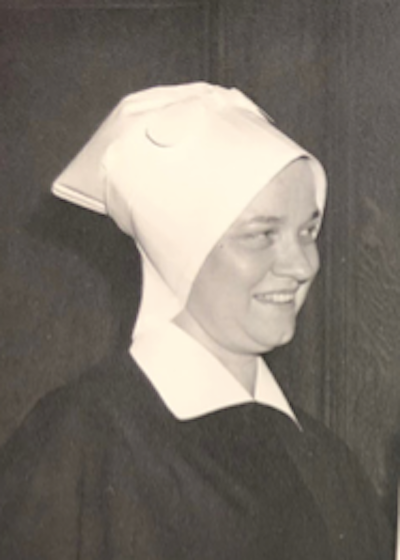
The dean of the School of Nursing at the time was Sister Angela Maria Carrico, SCN, and her office was in the old hospital complex, along with Father Edward B. Bunn, SJ, who was the nursing school’s regent prior to becoming president in 1952.
Quinn remembered Sister Angela Maria as somewhat strict and rule-oriented. One anecdote she described involved an evening when the College and the School of Nursing’s respective glee clubs held a joint concert.
“We wore gowns, and I had a gown that I wore that my mother had made for me – and it had very narrow straps on the shoulders, but my shoulders were bare,” she said. “So, after this glee club performance, I was summoned to her office.” Sister Angela Maria let Quinn know she was unhappy because the singing student had been “dressed inappropriately.”
A Jesuit named Father Love also had an office in the Nursing School, Quinn said, noting “you could just talk to him if you had any issues.” And she would also see and engage with the Jesuits, in their cassocks, in a courtyard by Jung Hall, a residence where the male students (aka “the boys”) lived at that time. (She recalled Father Fitzgerald.)
The Nursing Uniform
A young Jesuit, Father Whelan, also used to say Mass every morning in the chapel located in the old hospital, and Sister Angela Maria would use the opportunity to inspect the students’ hair length before they reported to the new hospital on Reservoir Road, Quinn recalled. (Hair that touched one’s collar had to be put up in a net.)
“The uniform was a blue-and-white-striped bag,” she joked. “Then, we had a detachable collar, short sleeves, and detachable cuffs – they were white and starched, very stiff. And then, there was an apron that was in two parts.”
She still has her apron and bib, which are “very yellowed with age.” The hospital, she remembered, would do uniform laundry for the students.
“And so, when we started in the hospital as probationers – ‘probies,’ we were called – I think that started probably midway in our second year,” she said. “So, we wore just the lower part of the apron. And then we had a special cap, the probie’s cap, that we wore. And then I guess it was in our junior year, we were capped. And then we got the Georgetown cap, and then we wore the bib with our apron.”
As seniors, the students had a blue and gray stripe that ran up and down the cap’s side. Upon graduation, the stripe ran across it. (Quinn has also preserved her cap and the stripe for all these years.)
“And we polished shoes every night,” Quinn highlighted. “We wore white shoes and white stockings, so your shoes had to be polished, and so that was kind of a ritual.”
‘Respected in Our Day, Too’
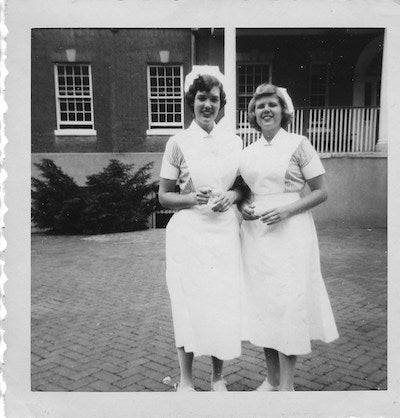
Quinn did not feel “there were any difficulties or any problems” being a woman student on campus in this period of time.
“As I say, [the nursing students] kind of traveled in a unit,” she said. “So, if we had a class some place, there were all of us going to the same place at the same time, being there at the same time. I don’t remember a lot of interaction with the males on campus.”
She did mention a time when she was playing tennis on the courts on campus and experienced “smart remarks,” but, generally, she said, “I don’t remember any difficulties or not being welcome or anything like that.”
Additionally, Quinn indicated that she did not experience negative perceptions around the study of nursing.
“No, I think in earlier years, nurses did not have the reputation that they do now,” she said. “I think we were respected in our day, too.”
By Bill Cessato
The author thanks Mrs. Nancy Geatz Quinn for sharing her edits and sending photos. Additional thanks to histories of Georgetown and the School of Nursing, authored respectively by Dr. Robert Emmett Curran (2010) and Dr. Alma Woolley (2001), for information about the campus, including administrators and buildings.
- Tagged
- Nursing History

